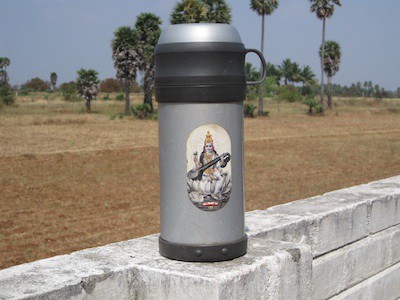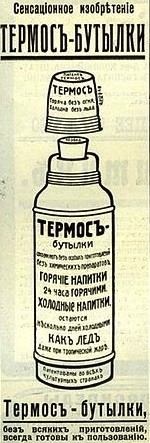The foreword
Taste reflects the presence of prana in food; insipid food does not give a normal feeling of saturation. Fresh and raw products, not treated by heat, have more saturated taste, but they are harder to digest and consequently are less nutritious. Cooked food is easy to digest, however, many microelements are being destroyed during boiling or in case of superfluous culinary operations, for example, frying followed by cooking etc. “Golden mean” is processing food at temperature below the boiling point, baking in oven or cooking according to “interval” principle – short-time heating followed by “ripening” at lower temperature. Energy and time consuming process of “cooking on a low flame” in modern conditions can be replaced by a usual Thermos. This wonderful household item was first made by German company Thermos GmbH in 1904. Dewar bottle (in the name of Scottish scientist, who invented it in 1892) used by chemists and physics for liquid gas was taken as the basis for Thermos.
Prana and kumbhaka
Kumbhaka and thermos visually reflect the application of the same principle but in different “spheres of knowledge”. In yogic practice – prana, a vital force, - is collected, kept and transformed in a body with the help of kumbhaka. Specific effect of pranayama is strengthening all kinds of Agni (internal fire) in a body. What happens in a body of a hatha yogi at physical level during a delay of breath? There is oxidation, heating, thermo-genesis and, depending on type of delay and bandhas, stimulation of tissue’s growth or detoxication. Speaking the language of classical texts “prana is sacrificed to prana”, i.e. there is a process of transformation of vital energy. It is also mentioned in texts that Agni is a digestive fire “devouring” various forms of prana received by a body from food and air. Agni, a transformation principle, is presented in a body not only as a digestive fire. According to Ayurveda besides jatharagni, generally localized in thin intestines, there are four more kinds of Agni. Together they are responsible for thermo balance, skin condition, tissue formation, sharpness and clearness of sight, ability to “digest” impressions correctly. Kumbha is translated as a vessel; a body is like a vessel containing energy of consciousness. Impressions are food for consciousness; they as well as products can be digestible and not quite. To facilitate digestion of both the mankind has invented ware and yoga. A small resume: A yogi practicing kumbhaka is a thermos. :)
Urgency
Probably, seeing the name of this article many have already hemmed mistrustfully: to eat out of thermos? However you should agree that in the most cases everyday life assumes two variants of food: 1) there is not enough time for meal 2) or there is almost no time. In the first case the majority heads to the nearest cafes, restaurants or Japanese pizzerias, in the second case the options are chocolates, tea, sandwiches and “lunches to the office”. As a rule due to ordinary circumstances a simple normal hot meal is not always possible not saying about a “special” one. Besides, in Moscow there are not enough vegetarian cafes or restaurants, and mainly they are not good. It does not mean that they cook badly; very often they do not cook food that is needed for a “captious” organism of a yogi or do it improperly. Irrespective of a café’s category food there is rarely charged with sattvic vibrations of a cook. Finally, food is hardly prepared according to ayurvedic rules: with ghee, with spices according to the season and your individual constitution. Therefore, continuing to develop the topic of fast food it is impossible to ignore a whole direction of yogic culinary thought – “fast food” in thermos.
Common mistakes
Certainly, if you are not affected by similar confusions, there is no reason to eat from a thermos. Even for the majority of those who have already “taken communion” to sticky mats, udjayi breathing and ghee, a perspective to use this “device” causes approximately the following number of associations:
1. “Professionally-ethical” Picking in a thermos as well as in ones nose with an iron spoon in the presence of colleagues and business partners is not ethical!
2. “Coquettishly-metro sexual” Thermos is so inconvenient; it does not fit the beautician and does not fit a purse.
3. “Courageous-aggressive” It is not tasty, because it is useful. It is impossible to prepare nothing but porridge, and what if I suddenly feel like to eat something different?
4. "Surrealistic" Thermos is rigid - there is no time to chew it for long!
Taste habits etc…
Let’s ask ourselves a question how taste habits and predilections are formed. The basic problem the majority of people willing “to eat correctly” face is an absence of pleasure received from such food. It is important to take into consideration a simple fact: there is food for peeping body maintenance, and there are impressions received from food’s taste, composition, appearance and social importance. Giving too much importance to mineral and vitamin composition, we lose sight of a current emotional condition, not quite realizing, what we eat for. As we understand “what for”, it naturally becomes not all the same - what, when and with whom we eat.
Undisciplined mind absorbs impressions by a principle “what I see is what I want”, simply because momentary satisfaction is pleasant to it (mind), and it does not want to stay in discomfort caused by “desired - not received”. There are lots of impressions around. Catching up too much at once the mind stays in an absent-minded condition. Receiving sensual information it differentiates it according to the internal inquiries and preferences, that is why it “sees only that it wants”. And the mind always wants a lot of different things.
Full pleasure – bhoga, differs from superficial pleasure – upabhoga, in a way that at superficial pleasure contact with object and pleasure happens without comprehending the process of getting pleasure. While there is a duality in mind there is also a desire that contains energy for its realization, this energy feeds our habits and attachments. Desire of pleasure cannot be satisfied if there is no full awareness while implementing the desired action. It disappears when the desired is completely reached and simultaneously it becomes clear that its full satisfaction is impossible. To feel the taste of life without feeling a thirst of desire - santosha – self-sufficiency, being satisfied with what there is.
Reasons and conditions
Einstein, as it is known, had clothes consisting of five-six absolutely identical suits so that their variety did not distract him from work. A yogi after 2-3 hour sessions of asanas or pranayama, being late for work, does not want to be distracted either, therefore sometimes he eats whatever his hand can reach. To form correct habits, it is necessary to realize the reasons of this desire and to create conditions for its realization. In case you practice yoga asanas and pranayama a thermos gives an indisputable advantage - everything that is “self-cooked” in it while you were busy in class or at work can be taken and eaten immediately, without thinking. The prize is not just an economy of time, but also is a quality of food. “Something wrong” often gets into the stomach not because we strongly desire it, but just because there are conditions created when “wrong” is always at your hand.
Advantages
So, what are the advantages of using a thermos compared to usual cooking? 1. Economy of time. Hot meal is always at your hand at the moment you need it. 2. An individual approach to nutrition. You cook for yourself what suits you to the greatest extend. 3. Minimum thermal treatment of products – it keeps taste, nutrient density and sattvic quality.




